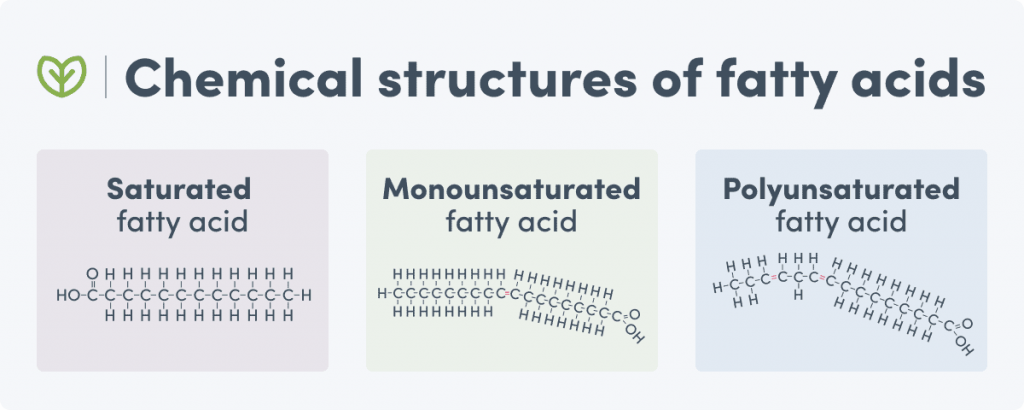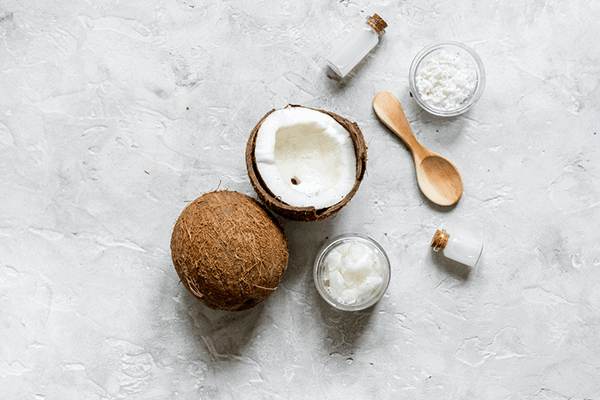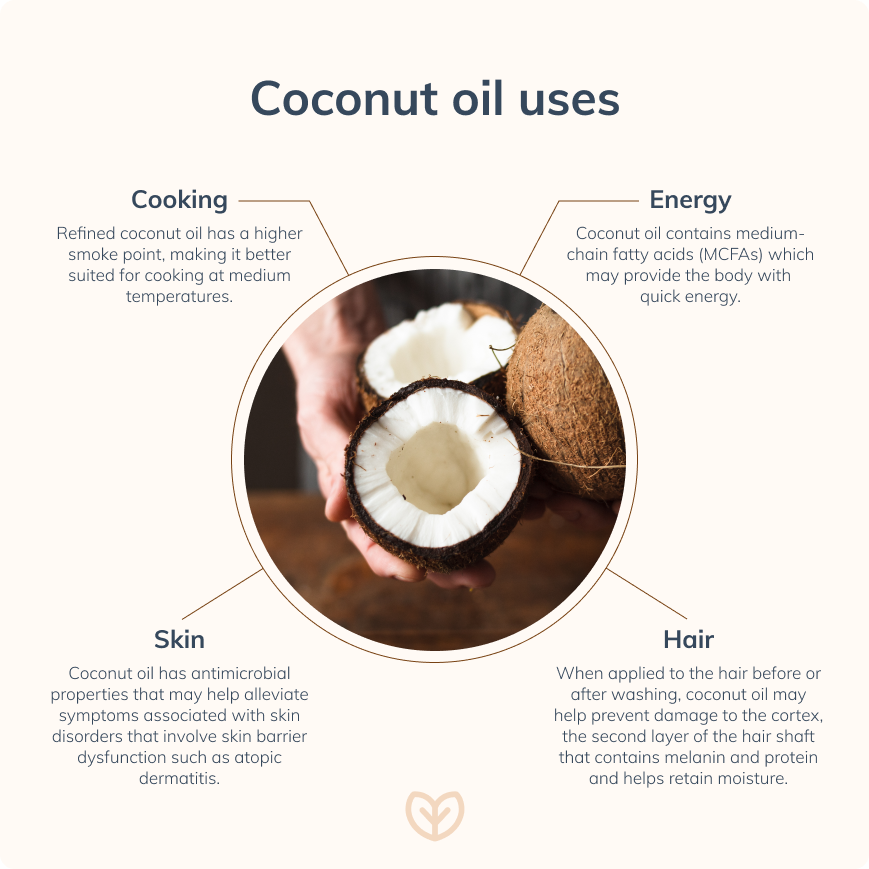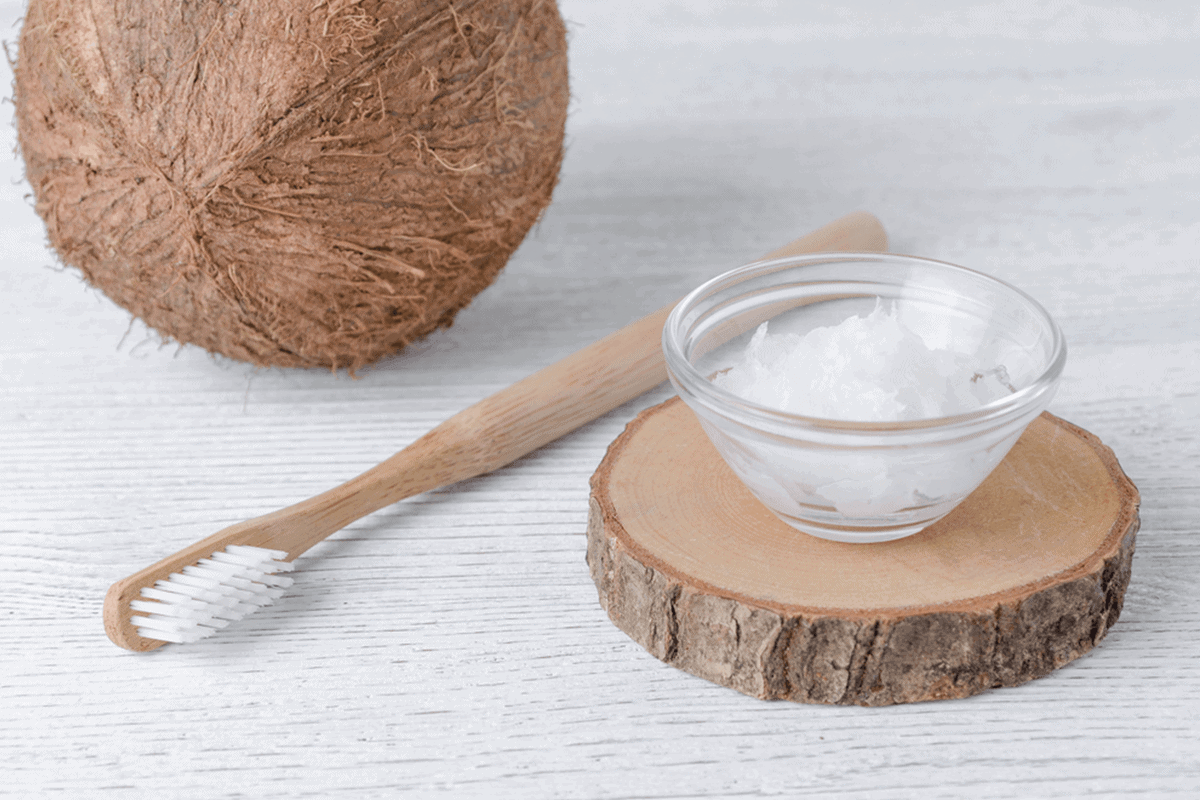What is coconut oil?
Often referred to as the tree of life, the coconut tree is a type of palm tree belonging to the Arecaceae family of plants that grows in tropical and subtropical regions. (9) Coconut oil is sourced from the kernel (white inner flesh) of the fruit of coconut trees. (9) Coconut and coconut-based products are important food sources for people living in the Philippines, Indonesia, India, and many other countries. (4) Exporting coconut products is also economically significant to these countries. The coconut industry is the leading employer of agricultural labor in the Philippines and 75% of its production is exported. (14) Coconut oil production is largely located in Asia; however, coconuts are cultivated in over 90 countries. (9)Coconut oil composition
Coconut oil is primarily composed of saturated fat, a type of fat that is saturated with hydrogen atoms and does not contain double bonds in its chemical structure. Dietary fats help the body perform critical functions in the body, such as synthesizing steroid hormones (e.g., testosterone, estrogen, progesterone) and increasing the bioavailability of fat-soluble vitamins consumed in the diet or through supplementation (i.e., A, D, E, and K). (2)
The degree of saturation refers to the number of hydrogen atoms located on the carbon chain of the fatty acid. Saturated fatty acids are “saturated” with hydrogen and do not contain double bonds. (2)
- Capric acid
- Caprylic acid
- Linoleic acid
- Myristic acid
- Oleic acid
- Palmitic acid
- Stearic acid (2)

Coconut oil is solid at room temperature. (2)
Refined vs unrefined coconut oil: what’s the difference?
There are different types of coconut oil available, each possessing distinct properties and health benefits. The two main types of coconut oil available on the market are virgin coconut oil, extracted from coconut milk, and crude coconut oil, extracted from coconut copra (dried coconut). (9) The extraction processes for these two types of coconut oil vary significantly and affect the look, taste, smell, quality, and nutritional value of the coconut oil. (9)(11)Virgin coconut oil
Virgin coconut oil (VCO) is extracted from the coconut milk through the mechanical pressing of fresh coconut meat in what is called a wet process. This process doesn’t use any chemical treatments and incorporates low heat levels. The emulsion of the oil from fresh coconut milk using the wet process can be extracted in three different ways: chilling and thawing, enzymatic extraction, and fermentation. (11) Chilling and thawing involves centrifuging (separating components of a fluid) the coconut milk for ten minutes and removing the upper layer of cream, letting it chill for 24 hours at 5°C (41°F), then thawing it in a hot water bath to extract the oil. (12) Enzymatic extraction involves mixing fresh coconut milk with enzymes and letting it stand for three hours at a temperature of approximately 55°C (131°F) before centrifuging the product to obtain the oil. The enzymatic extraction method is faster than the chilling and thawing method, but the chilling and thawing method may recover more oil. (12)(17) Fermentation involves mixing fresh coconut milk with distilled water at an equal ratio of 1:1, mixing in an inoculum (microorganism that aids fermentation), such as Baker’s yeast (Saccharomyces cerevisiae), to facilitate the fermentation process and letting it stand for 36 hours at room temperature before removing the upper layer of oil through decantation. The fermentation process may yield oil with higher lauric acid content compared to the chilling and thawing and enzymatic extraction methods. (12)Crude coconut oil
Crude coconut oil (CCO), sometimes referred to as copra oil, is extracted from whole coconuts that have been shredded and dried by the sun, over a fire, or in an oven. The dried coconut is then either mechanically pressed or dissolved with solvents in order to extract the coconut oil. (11) CCO is typically brown colored and contains components such as gums, pigments, trace metals, and waxes that can negatively impact the taste, smell, and appearance of the oil. (11) As a result, CCO is processed into refined, bleached, and deodorized coconut oil (RBDCO) in order to remove these components. (11) The refinement process involves four steps, including:- Degumming
- Neutralization
- Bleaching
- Deodorization
- Involves lower transportation costs compared to VCO
- Produces higher yields than VCO
- Requires less time and effort to produce
- Uses raw materials that are less susceptible to damage (11)
What is fractionated coconut oil?
Fractionated coconut oil includes separating fatty acids from coconut oil and making them into a new product. MCT oil (medium chain triglycerides) is a common type of fractionated coconut oil sold in stores. (13) To produce MTC oil, coconut oil is fractionated by hydrolysis (broken down by a chemical reaction with water), separating lauric acid and other fatty acids, and leaving only triglycerides that are rich in caprylic and capric fatty acids. (13) The separated lauric acid is often used to manufacture monolaurin, a monoglyceride shown to have antimicrobial and antiviral effects and is a derivative of lauric acid. (13) MCT oil is not suitable for cooking because of its low smoke point, (13) but is available as a nutritional supplement. In limited studies, MCT oil has been shown to promote improved weight management; however, further research is necessary. (1)(13)(19)Did you know? A smoke point refers to the temperature at which an oil or fat produces a steady amount of smoke and is helpful in determining whether the fat or oil is appropriate for cooking (e.g., frying). (2)
Coconut oil uses: what is coconut oil good for?

Coconut oil has many applications.
Coconut oil for cooking
Coconut oil has many applications for cooking and baking. The smoke point of VCO is 177°C (350°F) and the smoke point of RBDCO is approximately 205 to 230°C (400 to 450°F). (2)(3) Smoke points below 200°C (392°F) are not well suited for cooking at medium to high temperatures because the heat can damage the integrity of the fatty acids; therefore, frying VCO at high temperatures isn’t recommended. Try incorporating raw unheated VCO into recipes or using it for shallow low-heat sautéing. RBDCO is better suited for frying at medium temperatures. (2)Coconut oil and cholesterol levels
Researchers continue to examine the relationship between coconut oil consumption and cholesterol levels. (20) Cholesterol is a lipid molecule vital to maintaining the structural integrity of cells and aiding in the synthesis of vitamin D, steroid hormones, and bile acids. Lipoproteins (made up of protein and lipids) help carry cholesterol through the blood. (9) High-density lipoprotein (HDL), often referred to as “good cholesterol”, helps carry cholesterol back to the liver for removal from the body, while low-density lipoprotein (LDL), often referred to as “bad cholesterol”, helps transport cholesterol from the liver to cells throughout the body. In excess, LDL may lead to a buildup of plaque in blood vessels and raise your risk for heart disease. (8) The effects of coconut oil consumption on cholesterol levels vary from study to study, with several studies concluding that coconut oil increases LDL cholesterol levels, while others suggest that it increases HDL levels and may lower LDL levels. Much of the research on this topic has been conducted in animals and in vitro. More long-term control trials on human consumption of coconut oil are necessary. (15)(16) Certain variables, such as coconut oil type (VCO or RBDCO), dietary habits, and lifestyle may explain why studies have been largely inconclusive. For example, a study in rats looked at the consumption of VCO compared to copra oil and measured the lipid parameters and lipoprotein levels in vitro. They found that VCO may lower LDL cholesterol levels and that these results are likely linked to the antioxidant polyphenols present in VCO. (16) However, a systematic review and meta-analysis of 16 clinical trials that investigated the effect of coconut oil consumption on cardiovascular risk factors demonstrated that coconut oil consumption may increase LDL cholesterol compared to non-tropical vegetable oils. Two of the 16 studies included in the review specified the use of VCO and the remaining 14 did not report on the type of coconut oil used. (15) As a result, the health benefits specific to the type of coconut oil consumed may be an important variable to consider.Coconut oil for skin
Studies show that the antimicrobial properties of coconut oil may be helpful in alleviating symptoms associated with skin disorders that involve skin barrier dysfunction such as atopic dermatitis (AD). (10)
One of the benefits of coconut oil on skin is that it may alleviate symptoms associated with atopic dermatitis. (10)
Coconut oil for energy
Coconut oil may provide the body with quick energy. Coconut oil is digested differently than most other fats due to its MCFAs content. Much of the fat we consume is digested, broken down, and absorbed through the upper part of the small intestine. The fat is then broken down into smaller molecule parts, including fatty acids, glycerol, and monoglycerides, that travel through the lymph system and are repackaged as triglycerides (fat molecules) before being further broken down again to be used as energy or stored as adipose tissue. (2) The MCFAs found in coconut oil are mostly absorbed in the small intestine intact, and can be used as energy more quickly as a result. (2)Coconut oil for hair
Is coconut oil good for hair? When applied to the hair before or after washing, coconut oil may help prevent damage to the cortex, the second layer of the hair shaft that contains melanin and protein and helps retain moisture. (6)(18) In a study that examined the effects of different oils on preventing hair damage, researchers demonstrated that a hair pre-wash and post-wash of coconut oil reduced protein loss for both undamaged and damaged hair superior to mineral oil and sunflower oil. (18)The bottom line
Coconut oil is a unique plant-based saturated fat and approximately 50% of the total fat composition of coconut oil is lauric acid. The two main types of coconut oil available on the market are virgin coconut oil and refined, bleached, and deodorized coconut oil made from crude coconut oil. VCO may contain higher levels of antioxidants than RBDCO. Coconut oil benefits for topical use include preventing hair damage and alleviating skin lesions associated with atopic dermatitis. Coconut oil can provide quick energy; however, coconut oil for cooking is only recommended at medium to low temperatures.- Assunção, M. L., Ferreira, H. S., dos Santos, A. F., Cabral, C. R., Jr, & Florêncio, T. M. (2009). Effects of dietary coconut oil on the biochemical and anthropometric profiles of women presenting abdominal obesity. Lipids, 44(7), 593–601.
- Boateng, L., Ansong, R., Owusu, W. B., & Steiner-Asiedu, M. (2016). Coconut oil and palm oil’s role in nutrition, health and national development: A review. Ghana medical journal, 50(3), 189–196.
- Coconut Oil. (2020, July 14). Harvard School of Public Health. https://www.hsph.harvard.edu/nutritionsource/food-features/coconut-oil/
- DebMandal, M., & Mandal, S. (2011). Coconut (Cocos nucifera L.: Arecaceae): in health promotion and disease prevention. Asian Pacific journal of tropical medicine, 4(3), 241–247.
- Evangelista, M. T., Abad-Casintahan, F., & Lopez-Villafuerte, L. (2014). The effect of topical virgin coconut oil on SCORAD index, transepidermal water loss, and skin capacitance in mild to moderate pediatric atopic dermatitis: a randomized, double-blind, clinical trial. International journal of dermatology, 53(1), 100–108.
- Gavazzoni Dias M. F. (2015). Hair cosmetics: an overview. International journal of trichology, 7(1), 2–15.
- Kolb, L., & Ferrer-Bruker, S. J. (2020, August 13). Atopic Dermatitis. StatPearls.
- LDL and HDL Cholesterol: “Bad” and “Good” Cholesterol. (2020, January 31). National Center for Chronic Disease Prevention and Health Promotion.
- Lima, R., & Block, J. (2019). Coconut oil: what do we really know about it so far? Food Quality and Safety, 3(2), 61–72.
- Lin, T. K., Zhong, L., & Santiago, J. L. (2017). Anti-Inflammatory and Skin Barrier Repair Effects of Topical Application of Some Plant Oils. International journal of molecular sciences, 19(1), 70.
- Liu, R., Guo, X., Cheng, M., Zheng, L., Gong, M., Chang, M., Jin, Q., & Wang, X. (2019). Effects of chemical refinement on the quality of coconut oil. Journal of food science and technology, 56(6), 3109–3116.
- Mansor, T. S. T., Che Man, Y. B., Shuhaimi, M., Abdul Afiq, M. J., & Ku Nurul, F. K. M. (2012). Physicochemical properties of virgin coconut oil extracted from different processing methods. International Food Research Journal, 19(3), 837–845.
- McCarty, M. F., & DiNicolantonio, J. J. (2016). Lauric acid-rich medium-chain triglycerides can substitute for other oils in cooking applications and may have limited pathogenicity. Open heart, 3(2), e000467.
- Moreno, M., Kuwornu, J., & Szabo, S. (2020). Overview and Constraints of the Coconut Supply Chain in the Philippines. International Journal of Fruit Science, 20(2), S524–S541.
- Neelakantan, N., Seah, J., & van Dam, R. M. (2020). The Effect of Coconut Oil Consumption on Cardiovascular Risk Factors: A Systematic Review and Meta-Analysis of Clinical Trials. Circulation, 141(10), 803–814.
- Nevin, K. G., & Rajamohan, T. (2004). Beneficial effects of virgin coconut oil on lipid parameters and in vitro LDL oxidation. Clinical biochemistry, 37(9), 830–835.
- Raghavendra, S. N., & Raghavarao, K. S. M. S. (2010). Effect of different treatments for the destabilization of coconut milk emulsion. Journal of Food Engineering, 97(3), 341–347.
- Rele, A. S., & Mohile, R. B. (2003). Effect of mineral oil, sunflower oil, and coconut oil on prevention of hair damage. Journal of cosmetic science, 54(2), 175–192.
- St-Onge, M. P., & Jones, P. J. (2003). Greater rise in fat oxidation with medium-chain triglyceride consumption relative to long-chain triglyceride is associated with lower initial body weight and greater loss of subcutaneous adipose tissue. International journal of obesity and related metabolic disorders : journal of the International Association for the Study of Obesity, 27(12), 1565–1571.
- Teng, M., Zhao, Y. J., Khoo, A. L., Yeo, T. C., Yong, Q. W., & Lim, B. P. (2020). Impact of coconut oil consumption on cardiovascular health: a systematic review and meta-analysis. Nutrition reviews, 78(3), 249–259.





